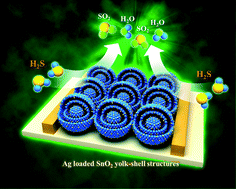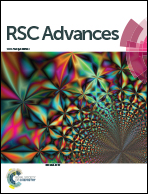High performance chemiresistive H2S sensors using Ag-loaded SnO2 yolk–shell nanostructures†
Abstract
SnO2 yolk–shell spheres uniformly loaded with Ag nanoparticles were prepared by a facile one-pot ultrasonic spray pyrolysis of the source solution and the H2S sensing characteristics were investigated. The Ag-loaded SnO2 yolk–shell spheres showed ultrahigh and reversible response (Ra/Rg − 1 = 613.9, where Ra is the resistance in air and Rg is the resistance in gas) to 5 ppm H2S with negligible cross-responses (0.6–17.3) to eight other interference gases at 350 °C. In contrast, pure SnO2 spheres with dense inner structures and yolk–shell morphologies did not exhibit a high response/selectivity to H2S nor reversible H2S sensing. The highly sensitive, selective, and reversible H2S sensing characteristics were explained in terms of the gas-accessible yolk–shell morphology and uniform loading of catalytic Ag nanoparticles. Namely, the gas-accessible yolk–shell morphology facilitated the rapid and effective diffusion of the analyte/oxygen gases and the uniform loading of Ag nanoparticles promoted the H2S sensing reaction.


 Please wait while we load your content...
Please wait while we load your content...